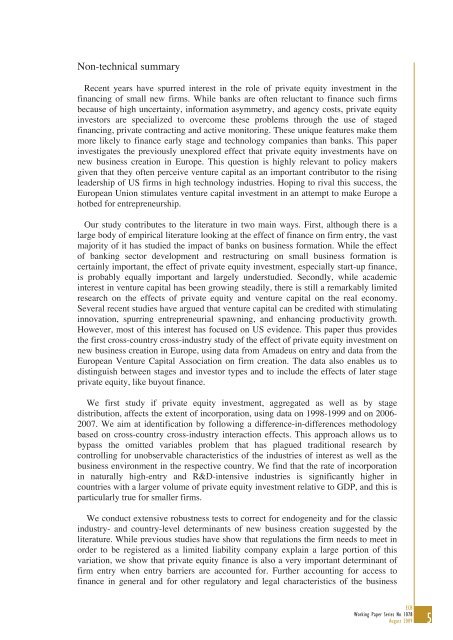On the real effects of private equity investment: evidence from new ...
On the real effects of private equity investment: evidence from new ...
On the real effects of private equity investment: evidence from new ...
- No tags were found...
You also want an ePaper? Increase the reach of your titles
YUMPU automatically turns print PDFs into web optimized ePapers that Google loves.
Non-technical summaryRecent years have spurred interest in <strong>the</strong> role <strong>of</strong> <strong>private</strong> <strong>equity</strong> <strong>investment</strong> in <strong>the</strong>financing <strong>of</strong> small <strong>new</strong> firms. While banks are <strong>of</strong>ten reluctant to finance such firmsbecause <strong>of</strong> high uncertainty, information asymmetry, and agency costs, <strong>private</strong> <strong>equity</strong>investors are specialized to overcome <strong>the</strong>se problems through <strong>the</strong> use <strong>of</strong> stagedfinancing, <strong>private</strong> contracting and active monitoring. These unique features make <strong>the</strong>mmore likely to finance early stage and technology companies than banks. This paperinvestigates <strong>the</strong> previously unexplored effect that <strong>private</strong> <strong>equity</strong> <strong>investment</strong>s have on<strong>new</strong> business creation in Europe. This question is highly relevant to policy makersgiven that <strong>the</strong>y <strong>of</strong>ten perceive venture capital as an important contributor to <strong>the</strong> risingleadership <strong>of</strong> US firms in high technology industries. Hoping to rival this success, <strong>the</strong>European Union stimulates venture capital <strong>investment</strong> in an attempt to make Europe ahotbed for entrepreneurship.Our study contributes to <strong>the</strong> literature in two main ways. First, although <strong>the</strong>re is alarge body <strong>of</strong> empirical literature looking at <strong>the</strong> effect <strong>of</strong> finance on firm entry, <strong>the</strong> vastmajority <strong>of</strong> it has studied <strong>the</strong> impact <strong>of</strong> banks on business formation. While <strong>the</strong> effect<strong>of</strong> banking sector development and restructuring on small business formation iscertainly important, <strong>the</strong> effect <strong>of</strong> <strong>private</strong> <strong>equity</strong> <strong>investment</strong>, especially start-up finance,is probably equally important and largely understudied. Secondly, while academicinterest in venture capital has been growing steadily, <strong>the</strong>re is still a remarkably limitedresearch on <strong>the</strong> <strong>effects</strong> <strong>of</strong> <strong>private</strong> <strong>equity</strong> and venture capital on <strong>the</strong> <strong>real</strong> economy.Several recent studies have argued that venture capital can be credited with stimulatinginnovation, spurring entrepreneurial spawning, and enhancing productivity growth.However, most <strong>of</strong> this interest has focused on US <strong>evidence</strong>. This paper thus provides<strong>the</strong> first cross-country cross-industry study <strong>of</strong> <strong>the</strong> effect <strong>of</strong> <strong>private</strong> <strong>equity</strong> <strong>investment</strong> on<strong>new</strong> business creation in Europe, using data <strong>from</strong> Amadeus on entry and data <strong>from</strong> <strong>the</strong>European Venture Capital Association on firm creation. The data also enables us todistinguish between stages and investor types and to include <strong>the</strong> <strong>effects</strong> <strong>of</strong> later stage<strong>private</strong> <strong>equity</strong>, like buyout finance.We first study if <strong>private</strong> <strong>equity</strong> <strong>investment</strong>, aggregated as well as by stagedistribution, affects <strong>the</strong> extent <strong>of</strong> incorporation, using data on 1998-1999 and on 2006-2007. We aim at identification by following a difference-in-differences methodologybased on cross-country cross-industry interaction <strong>effects</strong>. This approach allows us tobypass <strong>the</strong> omitted variables problem that has plagued traditional research bycontrolling for unobservable characteristics <strong>of</strong> <strong>the</strong> industries <strong>of</strong> interest as well as <strong>the</strong>business environment in <strong>the</strong> respective country. We find that <strong>the</strong> rate <strong>of</strong> incorporationin naturally high-entry and R&D-intensive industries is significantly higher incountries with a larger volume <strong>of</strong> <strong>private</strong> <strong>equity</strong> <strong>investment</strong> relative to GDP, and this isparticularly true for smaller firms.We conduct extensive robustness tests to correct for endogeneity and for <strong>the</strong> classicindustry- and country-level determinants <strong>of</strong> <strong>new</strong> business creation suggested by <strong>the</strong>literature. While previous studies have show that regulations <strong>the</strong> firm needs to meet inorder to be registered as a limited liability company explain a large portion <strong>of</strong> thisvariation, we show that <strong>private</strong> <strong>equity</strong> finance is also a very important determinant <strong>of</strong>firm entry when entry barriers are accounted for. Fur<strong>the</strong>r accounting for access t<strong>of</strong>inance in general and for o<strong>the</strong>r regulatory and legal characteristics <strong>of</strong> <strong>the</strong> businessECBWorking Paper Series No 1078August 20095















